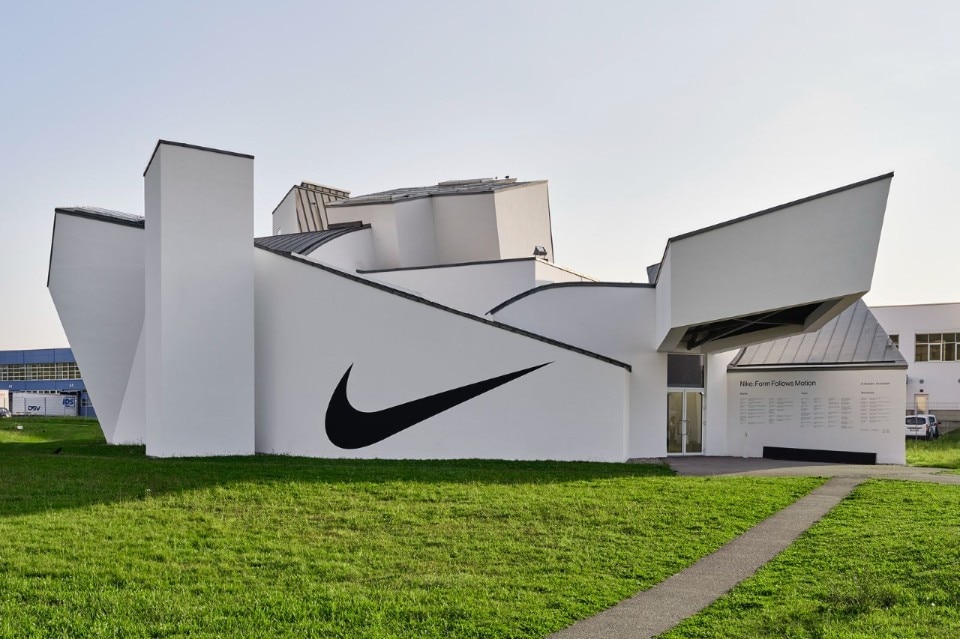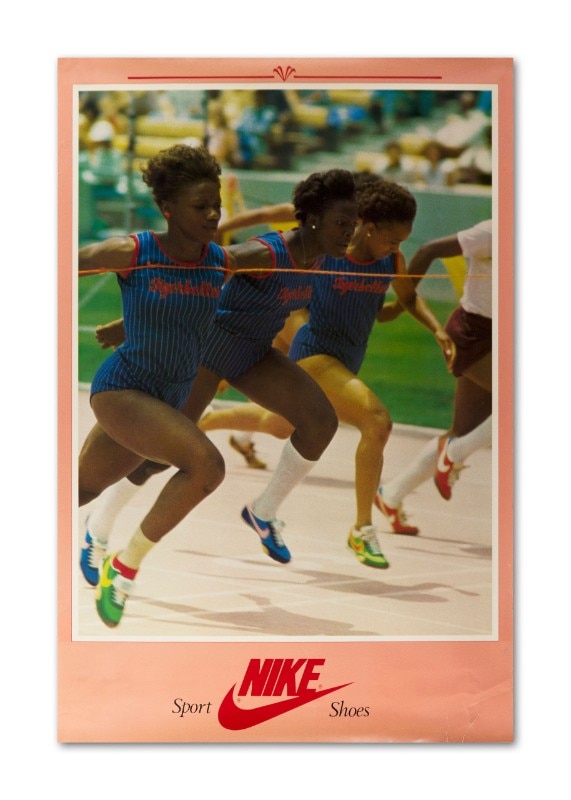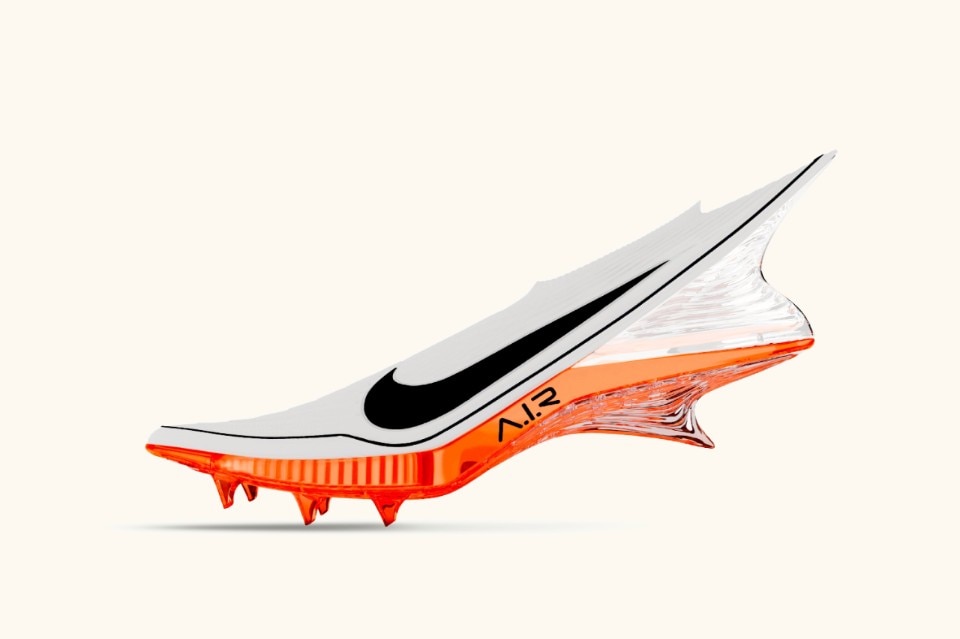by Giovanni Comoglio
An enormous, landscape-scale black Swoosh has appeared on that mass of curved lines and tormented white ribbon walls, that has been Frank Gehry’s first European endeavor: at a first glance, it seems to have always been a part of the composition. Then, anyone walking past the swoosh towards the interior is overwhelmed by a veritable swarm of shoes. What else, one might say, when Nike: form follows motion is the exhibition that Vitra Design Museum dedicates to the over-50-year history of the brand that, from Oregon, has decorated millions of bodies and feet with the mythological wing of the Nike of Samothrace.
There is, however, shining in transparency between those shoes, half a century of social and cultural history, at first the history of the West, then the history of a global world. The existence of the exhibition once again denounces the two-way transformative exchange connecting history and design. The very fact of looking at a shoe as the materialisation of a design process, and not just craftsmanship or art, is itself fairly recent history, although shoes have also been industrially manufactured since way before the 20th century.

The topic of a massive archive to be handle and disclosed stands out, the Department of Nike Archives - DNA with its 250,000 items including products, prototypes, documents, assembled over more than 20 years from different personal and corporate collections. “In a way, it’s more fascinating because it’s a collection of different histories already”, told us Glenn Adamson, exhibition curator and curator at large at Vitra “So it wasn’t based on certain objects to begin with, it was based on storylines: we developed a structure looking at different moments in the company's history, showing the idea of growth and the speed of that growth”. In a set-up, curated by Jaden Ali, that seeks the idea of structure visible in transparency, as on the side of an Air Max, and an anchoring of objects in a certain historical period, Adamson defined the spirit of the exhibition as “Looking at how engineering and expression can be combined in one design practice, one design culture. Objective-subjective. Science-art: it’s the convergence of those two opposites”.
If you look at the methodology of what Bill Bowerman was trying to do and what we are doing today, it's the same. He listened to athletes. He tried to make things better. He tinkered around. He innovated.
Martin Lotti, Nike Chief design officer

This is how the first room, Track, recounts the origins, all-American in Phil Kinght's desire to change a market (performance shoes) by taking his former coach, the later legendary Bill Bowerman, as product developer, through symbolic objects (the waffle machine that inspired the eponymous sole in the early 1970s) and fundamental figures, such as Carolyn Davidson who conceived the Swoosh logo and Diane Katz who made history by studying apparel, the first running parkas with their sloping line cape to respond to the rain. But it already tells of a change in social practices, of running moving from the track to the world of individual training. Ma già racconta un cambiamento nelle pratiche sociali, nella corsa che passa dalla pista al running come pratica non agonistica.
An uninterrupted athlete-producer-consumer exchange that is central as soon as one steps into the red room titled Air, with the large display case bringing together the shoes made for/by Michael Jordan and LeBron James around a shape materialising the trajectory of a basketball dunk. The innovation proposed to Nike by Frank Rudy also finds a place, i.e. suspending the shoes on an air cushion. An idea that might have gained a certain notoriety.

More collaborations as one moves on to the room dedicated to the present-future, Sensation, from the visual tales of the ‘mothership’ in Beaverton, Oregon, with its research facilities where athletes test and actually co-design new products, experiments such as FlyKnit, Shox shock absorbers, monolithic tomes and 3D-printed soles suspending runners on coral concretions made of recycled materials, all the way up to an acid yellow landscape where crystal showcases musealise the stories that have united Nike with Comme des Garçons, Riccardo Tisci, Elton John and Virgil Abloh, to name but a few.
Rather than exhausting in the totality of details all the complexity of such an articulated history, the exhibition opens up a whole landscape of stimuli and connections that restore the brand as a cultural product, even before being an industrial one. And this is also what Martin Lotti, Nike's chief design officer, opened up to us when he agreed to go “all the way design” with Domus, recounting the real driving forces behind the work of a team of more than 1,000 people, and accepting the game of summing up the history of the Swoosh in four milestones (which you will find in the gallery inside the article).

A methodology Lotti describes in: “Think of it as a movie. You start with the movie title, what is the story, then you find the actors, and it’s basically the item”. It is about concepts first – and there’s a whole new group focusing on concepts – then comes the product, then it’s the storytell. Differently from the past when a lot of product was created as a first step, the goal is now to go from items to ideas, becoming more holistic, so to connect with the training, with nutrition, with before, during, after one trains or competes.
Looking at how engineering and expression can be combined in one design practice, one design culture. Objective-subjective. Science-art: it’s the convergence of those two opposites.
Glenn Adamson, Vitra curator at large

 View gallery
View gallery

Waffle Machine
In 1971, while watching his wife Barbara prepare waffles, Bill Bowerman thought that the design of the plate would be ideal for a sole that would be as light and grippy as possible. The rest is history.
“Such a symbol of innovation and maverickness, with the idea of putting rubber into it and make something better for the athletes. We still use it at the campus as a symbol of how you stay grounded to authenticity”.
(Martin Lotti, Nike Chief design officer)
Courtesy Nike Form Follows Motion

Air
It was the aeronautical engineer Frank Rudy who proposed an air cushion as a shock absorber for running shoes, and it was Tinker Hatfield who had the idea to make it visible, inspired by the exposed structures of the Centre Pompidou: the Air Max 1 was born in 1987.
“It’s literally a tool, a cushioning platform that is still as good as in day one when it was invented. And we can improve upon it, yet the premise of it is the same. All the energy you put in, you get out, and it finds application in lifestyle, but also in the highest performance products. Of 18 of the last performance Olympic medals, 15 of them were won on Air”.
(Martin Lotti, Nike Chief design officer)
Courtesy Nike Form Follows Motion

Flyknit
The technology that debuted in 2012 is based on generating the upper part as a single piece of strong, lightweight fabric, with yarn density varying from point to point.
“When you can engineer to the exact specification down to the pixel, rather than taking rolled goods and gluing together, etc. It's a new method of make that literally revolutionized traditional shoemaking, and not just limited to footwear”.
(Martin Lotti, Nike Chief design officer)
Courtesy Nike Form Follows Motion

Tools of the future
In 2024, Nike teamed up with 13 of the world's best-known athletes, coupling their emotions with data collected by the Nike Sport Research Lab, to develop 13 new Nike Air model concepts through artificial intelligence.
“It’s less about tools. It's more about methodologies and approaches. So I think we’re in a whole new game when it comes to leveraging tools that you cannot even imagine yourself”. Martin Lotti, chief design officer for Nike
Nike A.I.R Faith Kipyegon. Courtesy Nike

Waffle Machine
In 1971, while watching his wife Barbara prepare waffles, Bill Bowerman thought that the design of the plate would be ideal for a sole that would be as light and grippy as possible. The rest is history.
“Such a symbol of innovation and maverickness, with the idea of putting rubber into it and make something better for the athletes. We still use it at the campus as a symbol of how you stay grounded to authenticity”.
(Martin Lotti, Nike Chief design officer)
Courtesy Nike Form Follows Motion

Air
It was the aeronautical engineer Frank Rudy who proposed an air cushion as a shock absorber for running shoes, and it was Tinker Hatfield who had the idea to make it visible, inspired by the exposed structures of the Centre Pompidou: the Air Max 1 was born in 1987.
“It’s literally a tool, a cushioning platform that is still as good as in day one when it was invented. And we can improve upon it, yet the premise of it is the same. All the energy you put in, you get out, and it finds application in lifestyle, but also in the highest performance products. Of 18 of the last performance Olympic medals, 15 of them were won on Air”.
(Martin Lotti, Nike Chief design officer)
Courtesy Nike Form Follows Motion

Flyknit
The technology that debuted in 2012 is based on generating the upper part as a single piece of strong, lightweight fabric, with yarn density varying from point to point.
“When you can engineer to the exact specification down to the pixel, rather than taking rolled goods and gluing together, etc. It's a new method of make that literally revolutionized traditional shoemaking, and not just limited to footwear”.
(Martin Lotti, Nike Chief design officer)
Courtesy Nike Form Follows Motion

Tools of the future
In 2024, Nike teamed up with 13 of the world's best-known athletes, coupling their emotions with data collected by the Nike Sport Research Lab, to develop 13 new Nike Air model concepts through artificial intelligence.
“It’s less about tools. It's more about methodologies and approaches. So I think we’re in a whole new game when it comes to leveraging tools that you cannot even imagine yourself”. Martin Lotti, chief design officer for Nike
Nike A.I.R Faith Kipyegon. Courtesy Nike
It's based on the combination of athlete needs, cultural needs and business needs, but it has to stay within the Nike DNA, and to stay in the playing zone of sport, culture, and youth.
This DNA “is the constant”, Lotti told us: “If you look at the methodology of what Bill Bowerman was trying to do and what we are doing today, it's the same. He listened to athletes. He tried to make things better. He tinkered around. He innovated. He tried to make things lighter, faster, more stable. We’re still trying to do this today. What has changed in our approach are the tools”.

There is then a chapter in Nike's history that is more apparently elusive because it is not directly a product, but is crucial in framing the brand as a player in contemporary design, the investment in the support of communities, of athletes or passionate people, with a growing inclination towards an expanding market: running, coincidentally the very point from which it all began. It is a foundation in the development of new projects, as Sabrina Oei, senior director for global running Communications, confirmed, but also in the cultural and social positioning of the brand.
Not only competing athletes have become Nike ambassadors, but also coaches and animators of social aggregations where sport becomes the gateway to physical and above all mental health that is increasingly unattainable in the performative and productivist society of recent years. Presenting the exhibition to a global running community by its opening was then not only Lotti but also two of these figures, London-based Dora Atim and New York-based Joe Holder, committed to bringing together as inclusive groups of urban inhabitants as possible around running; and in the midst of the event Holder was heard declaring how “people should not have to pay to train”. This is something opening the games again, with respect to the evolution of the brand in terms of how it will be told, effectively projecting it into the absolutely most political field of design.

Thinking about what could be a new exhibition ten or twenty years from now, the things that first come to mind are a wish and a question.
The wish goes to Vitra, not to remove the mega-swoosh from the wall once the current exhibition is over, but to paint over it, so as to consign Gehry's first European work to a new career of archaeological layering. The4 question instead is about what the next exhibition might be like – upon condition of this being held again in a design museum: will it still be so tangible, will there still be so many shoes? It was Virgil Abloh himself, the soul of so many small Off-White and Nike branded revolutions, who said, speaking of architecture – nothing but the design of life in spaces – that ‘Young architects can change the world by not building buildings’.
- Exhibition:
- Nike: Form Follows Motion
- Curated by:
- Glenn Adamson
- Dates:
- from 21st September 2024 to 4th May 2025
- Location:
- Vitra Design Museum, Weil am Rhein, Germany


























